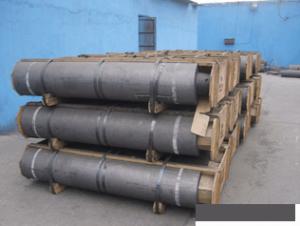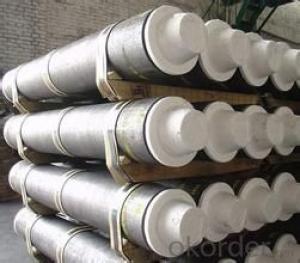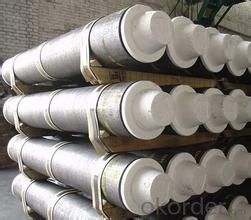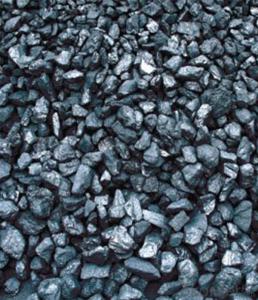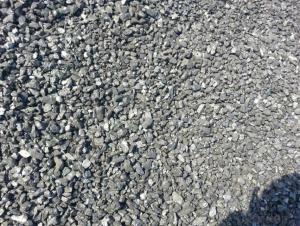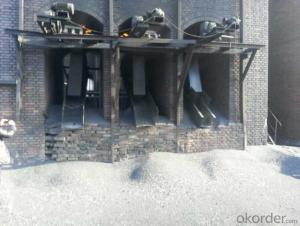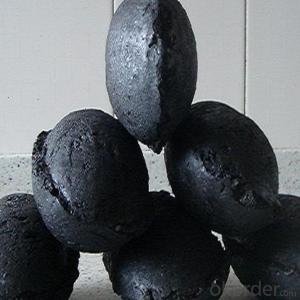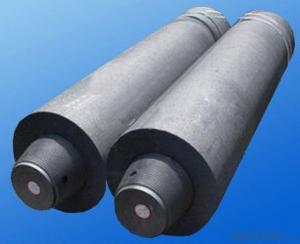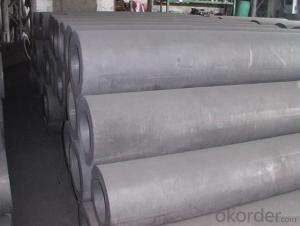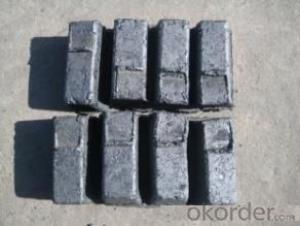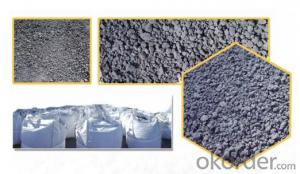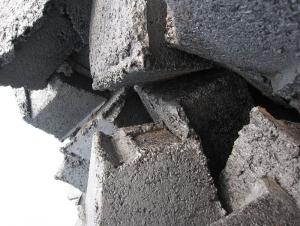Carbon Electrode with Different Size and High Quality
- Loading Port:
- Tianjin
- Payment Terms:
- TT OR LC
- Min Order Qty:
- 20 m.t.
- Supply Capability:
- 800 m.t./month
OKorder Service Pledge
OKorder Financial Service
You Might Also Like
Spcifications
1:carbon eletrode
2:for ferroalloy,calcium carbide, silicon metal, manufacture
Product Description
Carbon Electrode is abaked electrode used in submerged arc furnaces for delivering power to the charge mix. Electrode is added to the top of the electrode column cylindrical form. Electrode is essentially a mix of Electrically Calcined Anthracite (ECA) or Calcined Petroleum Coke (CPC) with Coal Tar Pitch and is baked for weeks, it is widly used for ferroally productiong, silicon metal production etc.
Graphite/Carbon Electrode Paste Specification:
| PARAMETER UNIT GUARANTEE VALUE | ||||||
| Items | Φ500~Φ700 | Φ750~Φ960 | Φ1020~Φ1400 | |||
| Rs μΩ.m | ≤45 | ≤38 | ≤45 | ≤38 | ≤40 | |
| Bulk Desity g/cm3 | ≥1.55 | ≥1.58 | ≥1.55 | ≥1.58 | ≥1.55 | ≥1.58 |
| Bending Strength MPa | 3.5~7.5 | 4.0~7.5 | 3.5~7.5 | 4.0~7.5 | 3.5~7.5 | 4.0~7.5 |
| Compressive Strength MPa | ≥20.0 | ≥20.0 | ≥20.0 | ≥20.0 | ≥19.0 | ≥19.0 |
| Compressive Strength MPa | 3.2~4.8 | 3.0~4.6 | 3.2~4.8 | 3.0~4.6 | 3.2~4.8 | 3.0~4.6 |
| Ash % | ≤2.5 | ≤2.0 | ≤2.5 | ≤2.0 | ≤2.5 | ≤2.0 |
Picture:
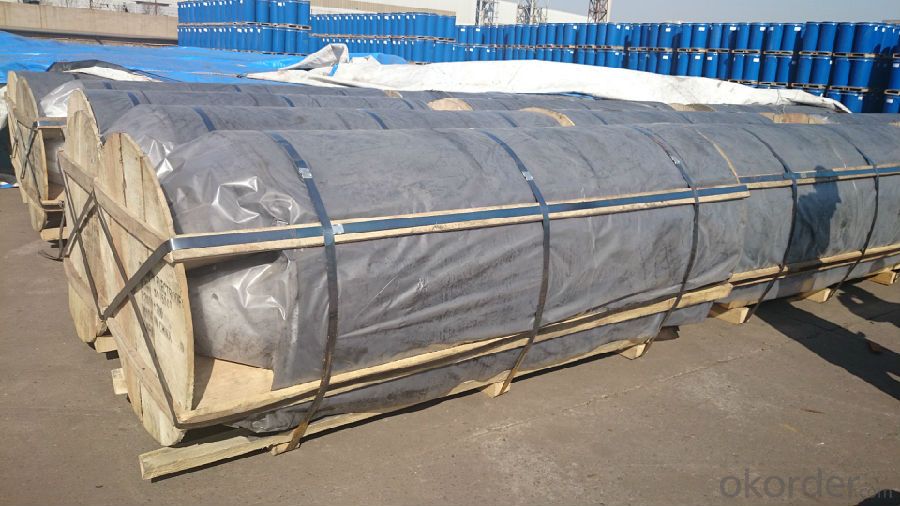
We Also supply all kind of carbon electrode paste and below materials, please contact us if you have any enquiry about it.
Calcined Anthracite
Calcined Petroleum Coke
Coke (Met Coke, Foundry Coke, Semi Coke)
Company information:
China National Building Materials Group is a stated -owned enterprise in charge of administrative affairs in China buiding materials industry.Established in 1984 CNBM is a large group corporation of building materials with total assets of 25 billion and a total stuff of 30000 CNBM now owns 200 subordinating firms of solely owned and joint-venture companies.
- Q: What are the 3K, 12K, UD, etc. in the appearance requirements of the carbon fiber bicycle? What's the difference?
- 3K has 220 grams and 240 grams a square meter, we do carbon fiber automotive supplies, that is, the higher the number of 3K K, the width of each bundle of carbon fiber filaments, each bundle has hundreds of silk composition
- Q: What is the difference in carbon content of low carbon steel, medium carbon steel and high carbon steel?
- The carbon content of medium carbon steel (AISI1029 to 1053) is 0.25% to 0.55%, manganese content is 0.30% to 1%, phosphorus content is not more than 0.04%, sulfur content is not more than 0.05%.
- Q: How does carbon occur in nature?
- Carbon occurs in nature in various forms and is one of the most abundant elements on Earth. It is found in the atmosphere, in the Earth's crust, and in living organisms. In the atmosphere, carbon exists primarily as carbon dioxide (CO2), which is produced through natural processes such as respiration, volcanic activity, and the decay of organic matter. This CO2 is then absorbed by plants during photosynthesis to produce energy and release oxygen. Carbon is also present in other greenhouse gases like methane (CH4), which is produced by natural processes such as the decomposition of organic matter in wetlands and the digestive processes of certain animals. In the Earth's crust, carbon is found in various minerals such as limestone, dolomite, and graphite. These minerals are formed through the deposition and accumulation of marine organisms, such as shells and skeletons of marine organisms, over millions of years. Carbon is also a key component of fossil fuels, including coal, oil, and natural gas, which are formed from the remains of ancient plants and animals buried and subjected to high pressure and temperature over time. Furthermore, carbon is an essential element for all living organisms and is the basis of organic chemistry. It is the key component of all organic matter, including carbohydrates, proteins, lipids, and nucleic acids, which form the building blocks of life. Carbon cycles through various biological processes, such as photosynthesis, respiration, and decomposition, allowing it to be continually recycled within ecosystems. Overall, carbon occurs naturally in the environment in different forms and plays a crucial role in the Earth's climate system, geological processes, and the sustenance of life.
- Q: Why vegetarianism can reduce carbon emissions?
- That is to say, when the level of the food chain is more, the carbon emissions are more natural; while the human eating vegetarian diet is the shortest food chain, which has the least carbon emissions
- Q: How does carbon impact the prevalence of droughts?
- Carbon impacts the prevalence of droughts by contributing to climate change. Increased levels of carbon dioxide in the atmosphere trap heat and lead to rising global temperatures. This enhanced greenhouse effect alters weather patterns and increases the frequency and severity of droughts in many regions around the world.
- Q: What are the consequences of increased carbon emissions on public health systems?
- Public health systems are significantly affected by the increase in carbon emissions. One of the main consequences is the worsening of respiratory diseases like asthma, COPD, and bronchitis. These conditions are aggravated by the presence of fine particulate matter (PM2.5) and ground-level ozone, both of which can deeply penetrate the respiratory system. Furthermore, higher levels of carbon emissions are linked to a higher occurrence of cardiovascular diseases. The release of fine particulate matter and other pollutants from carbon-emitting sources can enter the bloodstream, leading to inflammation, oxidative stress, and the development of atherosclerosis. This can eventually result in heart attacks, strokes, and other cardiovascular complications. Additionally, the spread of infectious diseases is also influenced by climate change, which is driven by carbon emissions. The rise in temperatures and changes in precipitation patterns create favorable conditions for disease-carrying vectors like mosquitoes and ticks. This facilitates the transmission of diseases such as malaria, dengue fever, Lyme disease, and Zika virus. Moreover, extreme weather events and natural disasters associated with climate change can disrupt healthcare infrastructure and limit access to essential services, further impacting public health systems. Moreover, mental health is affected by the increase in carbon emissions as well. The degradation of the environment caused by carbon emissions contributes to feelings of anxiety, stress, and depression, often referred to as eco-anxiety or climate grief. The loss of biodiversity, destruction of natural habitats, and the general uncertainty about the future can have harmful effects on individuals and communities, requiring additional resources and support from public health systems. In conclusion, the consequences of increased carbon emissions extend far beyond the environment and have a profound impact on public health systems. They contribute to the prevalence of respiratory and cardiovascular diseases, facilitate the spread of infectious diseases, and affect mental health. It is crucial to address carbon emissions and adopt sustainable practices to mitigate these consequences and protect the well-being of individuals and communities.
- Q: How do fossil fuels release carbon dioxide when burned?
- By burning fossil fuels, carbon dioxide (CO2) is released as a byproduct. This occurrence is a result of the chemical makeup of fossil fuels. Fossil fuels, including coal, oil, and natural gas, primarily consist of hydrocarbons, which are compounds made up of carbon and hydrogen atoms. During the process of combustion, these hydrocarbons undergo a reaction with oxygen (O2) present in the air, leading to the production of carbon dioxide and water vapor. The chemical equation for the combustion of a hydrocarbon fuel, like the octane found in gasoline, can be represented as follows: C8H18 + 12.5O2 → 8CO2 + 9H2O In this reaction, each molecule of octane (C8H18) combines with 12.5 molecules of oxygen (O2) to yield 8 molecules of carbon dioxide (CO2) and 9 molecules of water (H2O). The carbon atoms contained within the hydrocarbons of fossil fuels bond with oxygen to create carbon dioxide. This release of carbon dioxide into the atmosphere is what contributes to the greenhouse effect and global warming. The combustion of fossil fuels serves as a significant source of anthropogenic (human-caused) carbon dioxide emissions, making up a substantial portion of the greenhouse gases discharged into the atmosphere. It is important to acknowledge that the burning of fossil fuels also results in the release of other harmful pollutants, such as sulfur dioxide (SO2) and nitrogen oxides (NOx), which have detrimental effects on air quality and human health. To address the adverse impacts of fossil fuel combustion, endeavors are underway to develop cleaner and more sustainable sources of energy, such as renewable energy, in order to diminish our reliance on fossil fuels and decrease carbon dioxide emissions.
- Q: What is carbon neutral manufacturing?
- Carbon neutral manufacturing refers to the process of manufacturing goods while minimizing or offsetting the carbon emissions associated with the production. It involves reducing greenhouse gas emissions at every stage of the manufacturing process, from sourcing raw materials to the disposal of finished products. This can be achieved through various measures such as energy efficiency, the use of renewable energy sources, implementing sustainable practices, and investing in carbon offset projects. To become carbon neutral, manufacturers typically start by conducting a detailed assessment of their carbon footprint, which involves identifying and quantifying all the emissions generated in their operations. This includes direct emissions from manufacturing processes, as well as indirect emissions from the energy sources they use. Once the emissions are measured, manufacturers can develop strategies to reduce their carbon footprint. Some common methods of achieving carbon neutrality in manufacturing include optimizing energy consumption by using efficient equipment and technologies, adopting renewable energy sources like solar or wind power, and implementing waste reduction and recycling programs. Additionally, manufacturers can invest in carbon offset projects, which are initiatives that reduce or remove greenhouse gas emissions from the atmosphere, such as reforestation or renewable energy projects. By implementing these measures and offsetting any remaining emissions, manufacturers can achieve carbon neutrality. This not only helps combat climate change by reducing the overall carbon footprint but also demonstrates a commitment to sustainability and environmental responsibility. Carbon neutral manufacturing is an important step towards transitioning to a low-carbon economy and creating a more sustainable future.
- Q: How does carbon impact the energy balance of the Earth?
- Carbon impacts the energy balance of the Earth by trapping heat in the atmosphere through the greenhouse effect. This leads to an increase in global temperatures, known as global warming, and disrupts the natural equilibrium of energy flow on the planet.
- Q: What is the concept of carbon equivalent? What is the relationship between carbon equivalent and weldability?
- C equivalent =[C+Mn/6+ (Cr+Mo+V) /5+ (Ni+Cu) /15]*100% formula: C, Mn, Cr, Mo, V, Ni, Cu are elements in the steel contentCarbon steel, determine the strength and weldability of the main factors is the carbon content. Alloy steel (mainly low-alloy steel) in addition to all kinds of alloy elements on the strength of carbon steel and welding also plays an important role.
Send your message to us
Carbon Electrode with Different Size and High Quality
- Loading Port:
- Tianjin
- Payment Terms:
- TT OR LC
- Min Order Qty:
- 20 m.t.
- Supply Capability:
- 800 m.t./month
OKorder Service Pledge
OKorder Financial Service
Similar products
Hot products
Hot Searches
